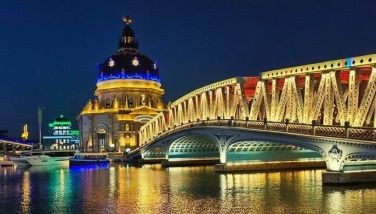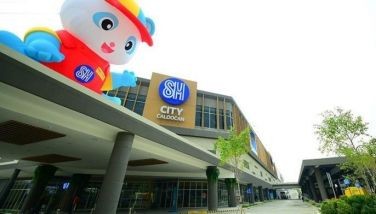JARDIN BOTANICO: Mid-morning in the garden of good and civil
June 9, 2001 | 12:00am
 Last Tuesday, June 5, was World Environment Day. The Heritage Conservation Society (HCS) decided to celebrate it with a morning picnic at the splendid Arroceros Forest Park by the Pasig River. The picnic was a celebration of the fact that there were still some clean and green areas in this smog-engulfed, olfactorically-offensive city. It was also an occasion to reach out to the public and to government officials with a call to save the fast disappearing heritage of the city’s architecture and parks.
Last Tuesday, June 5, was World Environment Day. The Heritage Conservation Society (HCS) decided to celebrate it with a morning picnic at the splendid Arroceros Forest Park by the Pasig River. The picnic was a celebration of the fact that there were still some clean and green areas in this smog-engulfed, olfactorically-offensive city. It was also an occasion to reach out to the public and to government officials with a call to save the fast disappearing heritage of the city’s architecture and parks.
The event was billed "HCS Picnic at the Park – with Mayor Atienza." Civil society and civic groups were out in full force. Among those in attendance were National Artist Andrea Veneracion and her Madrigal Singers, HCS stalwarts Toti Villalon, John Silva, Giana Montinola, Carlos Celdran, Dom Galicia, host Maan Hontiveros, NCCA Executive Director Virgilio Almario, Chita Gatbonton, Rita Ledesma, Bal Endriga, environmentalist Odette Alcantara, sociologist Randy David, Censors Chief Anding Roces, and as many more as there were shade trees in what was an abandoned DECS compound. Kudos to Mrs. Paterno of the Winners Group and Ime Sarmiento of the Clean and Green Foundation and other NGOs and sponsors.
 Baritones Gamaliel Viray, Elmo Makil and Emmanuel Gregorio sang "I think that I shall never see a poem as lovely as a tree." The serenade and picnic was also meant to win the hearts of government officials like reelected Mayor Lito Atienza, who was out of town, but was represented by Councilor Cita Astals. Vice-mayor-elect Danny Lacuna was also at the function and spoke of the city government’s support. It was wonderful to hear from him and other officials, though previous experience with the city government has had a "demolishing" effect on initiatives to save Manila’s irreplaceable landmarks.
Baritones Gamaliel Viray, Elmo Makil and Emmanuel Gregorio sang "I think that I shall never see a poem as lovely as a tree." The serenade and picnic was also meant to win the hearts of government officials like reelected Mayor Lito Atienza, who was out of town, but was represented by Councilor Cita Astals. Vice-mayor-elect Danny Lacuna was also at the function and spoke of the city government’s support. It was wonderful to hear from him and other officials, though previous experience with the city government has had a "demolishing" effect on initiatives to save Manila’s irreplaceable landmarks.
The ongoing concern for the conservation of urban landmarks has been heightened of late due to the plans of the city to add a multi-level parking garage behind the Metropolitan Museum and to relocate the City College to the Mehan Gardens. The Gardens are a public resource of open and green space that have been deteriorating into a repository of ill-designed monuments, forgotten fountains and underused public facilities (the city library is tucked in one dark corner).
The Mehan Gardens and the entire area north of the Intramuros is a historic site that contains several layers of the city’s compelling narrative of urbanization. The area was the original site of the Chinese enclave or the Parian in the 16th century. It was the site of the first hospital complex run by the Dominicans as well as the site of one of the earliest printing presses in the colonial world.
The Parian was moved to across the banks in the next century, as the Spaniards grew wary of the Sangleys. The area was cleared in the late 17th century after the short British takeover, to assure a clean "field of fire" as a deterrent to future invaders. In the next century, with this threat reduced, the area was allowed to be built on again with a cigar factory and a military hospital, a slaughterhouse and one of the city’s first theaters. This was all because Intramuros was fast filling up with people and buildings.
To give this expanding city some breathing space, the Spanish Governor Fernando de Norzagaray, upon the prompting of the city council, issued a decree on September 13, 1858 to (devote) the field of Arroceros to plants and making it a park and place of recreation for the public. Norzagaray’s decree further stated that – convenience and utility – would come of establishing a botanical garden, which would at the same time be a school of practical agriculture and the acclimatization of exotic fruits.
The Jardin Botanico was located east of Intramuros on a field of approximately five hectares. It not only served as a place for leisure and recreation but also functioned as an R & D and educational facility to further the country’s agricultural and economic development. A naturalist from Barcelona, Sebastian Vidal y Soler, was appointed as director of the Botanic Gardens. Under his guidance the park was built and maintained. Señor Vidal y Soler was successful in his management of the gardens and his work was much appreciated by the elite as well as the general public. Señor Vidal was also popular because of his wife, Ella. She was an elegant American lady from Philadelphia and was the toast of the town.
 Manila was not left behind other cities in the world in establishing parks. It was at about this time that the American landscape architect Frederick Law Olmsted was completing New York’s Central Park. In Paris, Adolphe Alphand had also just built the numerous public parks that were stipulated in Baron Hausmann’s famous rebuilding of the City of Lights. Because of good public support and the able directorship of Señor Vidal, Manila could rightfully boast the most beautiful (albeit formal, western type) park in the Orient.
Manila was not left behind other cities in the world in establishing parks. It was at about this time that the American landscape architect Frederick Law Olmsted was completing New York’s Central Park. In Paris, Adolphe Alphand had also just built the numerous public parks that were stipulated in Baron Hausmann’s famous rebuilding of the City of Lights. Because of good public support and the able directorship of Señor Vidal, Manila could rightfully boast the most beautiful (albeit formal, western type) park in the Orient.
Sadly, Señor Vidal died in 1889 (a statue was erected in the gardens in his honor) and the Philippines found itself soon engulfed in a revolutionary war, then an imperialist take-over. The Americans arrived to find the gardens as well as the city in disrepair and general urban malaise because of the two wars. Quickly, the Americans set out to rebuild the city in its (America’s) urban image. Daniel Burnham was commissioned to produce a "City Beautiful Plan" which he submitted in 1905. It was a blueprint for the original true, good and beautiful vision of a city of man.
Part of this vision was a parks and parkway system and Burnham did not fail to include the Jardin Botanico in the new plan. He integrated it into a magnificent scheme for civic buildings in a layout stretching from the Luneta to the Pasig River. The Jardin Botanico was reinvented as an open space for recreation to serve as a setting and foreground for what was intended to be a complex of buildings.
John C. Mehan, head of Sanitation and Parks for the city, rehabilitated the Jardin Botanico. Mehan was part of the first contingent of troops shipped here during the Filipino-American war. He stayed on and found work with the new civil government of Manila. Mehan is credited with establishing the first nurseries for street trees and planting for the city. He was also responsible for the establishment of the city’s new cemeteries and also set up the first organized system of garbage collection for the city. After his death, the municipal government renamed the Jardin Botanico to the Mehan Gardens.
The Gardens was the city’s first large public park. It held this function as well as that of the city zoo until the late Fifties when the Manila Zoo was built and Rizal Park started development. The Metropolitan Theater and the Post Office were built in the early Thirties to anchor this side of the city and turn it into one of the most picturesque quarters of the metropolis. (The archival pictures shown with this article are some of my favorite shots of how Manila was once truly beautiful.)
The last quarter of the 20th century has not been too kind to the area. A spider-web of flyovers has blighted Liwasang Bonifacio into a soot-filled no-man’s land. The Mehan Gardens, the Metropolitan Theater, the Post Office, and the other government offices in the area are neglected, ill-used or under threat of demolition. The fragmented ownership of these has also led to less-than-coordinated initiatives to improve the area and give it a semblance of civic pride.
The city government is under pressure once more to build on the only parcels it has control of – the Mehan Gardens. Like the Jai Alai, it too may be erased from our collective memory as the city seeks to house needed facilities. But many question the lack of alternatives citing the unused or abandoned buildings in the area. Buildings like the old GSIS headquarters, the Veterans building, even the Luneta are viable options.
Even more creative solutions to the city government’s problems of lack of space could be discovered by taking a wider view of urban regeneration. A radical intervention would be to remove the flyovers at Plaza Lawton and shunt traffic in an underground system that would incorporate three levels of parking, enough to address the needs of the area including Intramuros. This could cover the needs of the LRT "park and ride," free the ground for the recovery of the Plaza with views of the Post Office and Metropolitan Theater, and generate income for the city government. (The proposal would also allow for archaeological investigation before the actual construction of the complex.)
This proposal is not so impossible, as other cities in Asia have taken similar approaches, ones that prioritize pedestrian and public needs above expediency and vehicular oppression. Singapore and Hong Kong’s inter-modal complexes are a case in point. Our city mayors and public works authorities are all aware of these built projects. Even Kuala Lumpur and Ho Chi Minh City have overtaken Manila in boldness of vision and intensity of political will to improve their cities without sacrificing heritage.
Any proposal should look at conserving whatever open space we have and if possible recover (as the scheme above does) whatever we have lost to the tyranny of concrete and pollutive traffic. All this will give us back our Jardin Botanico, which will have to be designed as a modern park, with vibrant activities linked to a reconstructed Metropolitan Theater and integrated with the Arroceros Forest Park.
All that is needed is for civil society to act decisively and constructively to save what remains of our urban dignity.
The HCS will also be hosting another of its popular walking tours. The HCS Tour of Intramuros will be conducted by famed scholar and writer Fr. Rene Javellana, SJ, on Saturday, June 23.
For details and reservations for both activities, call the HCS Secretariat at 521-22-39 or fax at 522-24-97. Better yet, visit the society’s website at www.hcsphils.org.
BrandSpace Articles
<
>



















